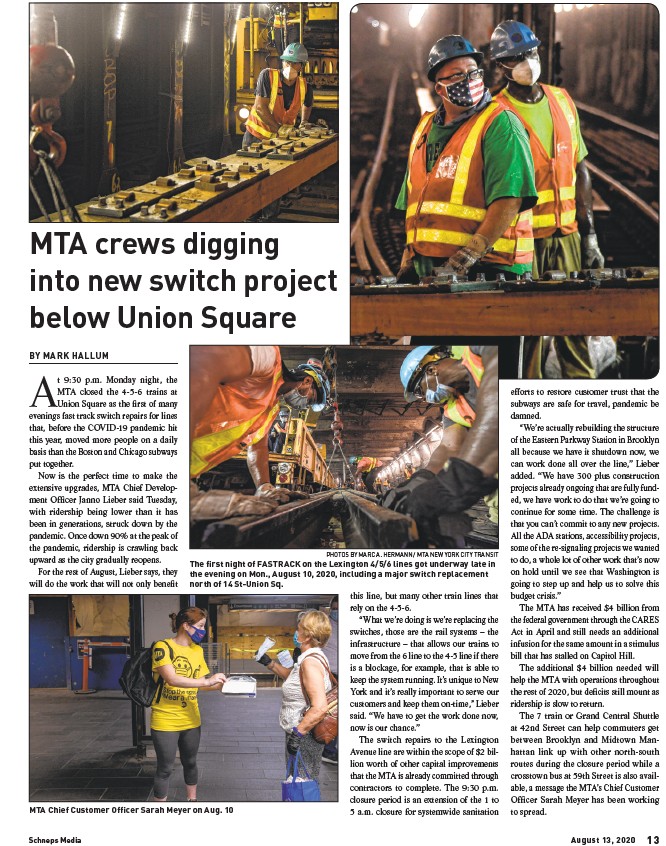
MTA crews digging
into new switch project
below Union Square
BY MARK HALLUM
At 9:30 p.m. Monday night, the
MTA closed the 4-5-6 trains at
Union Square as the fi rst of many
evenings fast track switch repairs for lines
that, before the COVID-19 pandemic hit
this year, moved more people on a daily
basis than the Boston and Chicago subways
put together.
Now is the perfect time to make the
extensive upgrades, MTA Chief Development
Offi cer Janno Lieber said Tuesday,
with ridership being lower than it has
been in generations, struck down by the
pandemic. Once down 90% at the peak of
the pandemic, ridership is crawling back
upward as the city gradually reopens.
For the rest of August, Lieber says, they
will do the work that will not only benefi t
PHOTOS BY MARC A. HERMANN / MTA NEW YORK CITY TRANSIT
The first night of FASTRACK on the Lexington 4/5/6 lines got underway late in
the evening on Mon., August 10, 2020, including a major switch replacement
north of 14 St-Union Sq.
this line, but many other train lines that
rely on the 4-5-6.
“What we’re doing is we’re replacing the
switches, those are the rail systems – the
infrastructure – that allows our trains to
move from the 6 line to the 4-5 line if there
is a blockage, for example, that is able to
keep the system running. It’s unique to New
York and it’s really important to serve our
customers and keep them on-time,” Lieber
said. “We have to get the work done now,
now is our chance.”
The switch repairs to the Lexington
Avenue line are within the scope of $2 billion
worth of other capital improvements
that the MTA is already committed through
contractors to complete. The 9:30 p.m.
closure period is an extension of the 1 to
5 a.m. closure for systemwide sanitation
efforts to restore customer trust that the
subways are safe for travel, pandemic be
damned.
“We’re actually rebuilding the structure
of the Eastern Parkway Station in Brooklyn
all because we have it shutdown now, we
can work done all over the line,” Lieber
added. “We have 300 plus construction
projects already ongoing that are fully funded,
we have work to do that we’re going to
continue for some time. The challenge is
that you can’t commit to any new projects.
All the ADA stations, accessibility projects,
some of the re-signaling projects we wanted
to do, a whole lot of other work that’s now
on hold until we see that Washington is
going to step up and help us to solve this
budget crisis.”
The MTA has received $4 billion from
the federal government through the CARES
Act in April and still needs an additional
infusion for the same amount in a stimulus
bill that has stalled on Capitol Hill.
The additional $4 billion needed will
help the MTA with operations throughout
the rest of 2020, but defi cits still mount as
ridership is slow to return.
The 7 train or Grand Central Shuttle
at 42nd Street can help commuters get
between Brooklyn and Midtown Manhattan
link up with other north-south
routes during the closure period while a
crosstown bus at 59th Street is also available,
a message the MTA’s Chief Customer
Offi cer Sarah Meyer has been working
to spread.
MTA Chief Customer Officer Sarah Meyer on Aug. 10
Schneps Media August 13, 2020 13